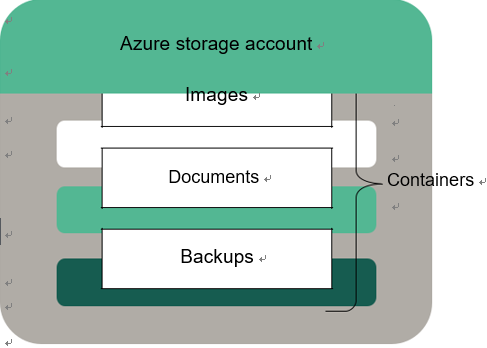CONTAINER
Containers in Azure Blob storage are similar to directories in a file system. They provide a way to organize sets of blobs, such as text files, images, or other media. A blob is a file of any type and size, and there are three types: block blobs, append blobs, and page blobs. Containers are ideal for grouping blobs in a systematic way, making data management more efficient and accessible.
Here are the key characteristics of containers:
■■ Access control: Containers can have different access levels such as private, blob-level public access, or container-level public access.
■■ Scalability: They can store a massive number of blobs, including large blobs, making them highly scalable.
■■ Security: Containers can be integrated with Azure Active Directory and other Azure security features.
■■ Figure 3-7 shows an Azure Storage account with multiple containers.

FIGURE 3-7 Multiple containers, each containing a different type of blob
Skill 3.1: Describe capabilities of Azure Storage CHAPTER 3 79
Types of blobs
The versatility of Azure Blob storage is primarily due to its ability to support different types of blobs. Each blob type is optimized for a specific kind of operation or use case, making blob storage highly adaptable and applicable to various scenarios. Let’s delve into each blob type more extensively.
■■ Block blobs: Block blobs are designed to handle a large amount of data efficiently.
A single block blob can contain up to 50,000 blocks of up to 100 MB each, which means a single block blob can handle data up to approximately 4.75 TB. Block blobs are ideal for scenarios where data size can range from small to massive, such as serving images to documents directly to a browser or storing backup files, media files for streaming, and high-resolution images.
Moreover, Azure supports uploading large block blobs in parallel, so you get efficient data transfer. Block blobs also support various operations such as adding, uploading, committing, and deleting blocks.
■■ Append blobs: Append blobs, as the name suggests, are optimized for append opera-tions, making them the perfect choice for logging data from virtual machines or storing telemetry data. They are similar to block blobs but are designed to handle append operations efficiently. An append blob can be modified by appending blocks, but blocks cannot be updated or deleted, providing a simple and efficient solution for scenarios where data needs to be only added.
These blobs can handle data up to approximately 195 GB and are highly useful for operations such as capturing the output of log files.
■■ Page blobs: Page blobs are designed for random access scenarios and can support up to 8 TB of data. They provide the ability to read/write pages and are ideal for scenarios where random read/write operations are frequent. A primary example of page blob usage is Azure’s implementation of virtual hard drives (VHDs) for its virtual machines.
In the case of Azure VMs, the VM operating system drives and any additional data drives are all stored as page blobs.
Page blobs allow transactional changes, meaning you can modify, add, and update a range of pages within a blob independently, a feature that makes them perfect for serv-ing as disks for Azure VMs or other services that require heavy read/write operations.
Understanding these different blob types and their ideal use cases will help you make informed decisions when implementing solutions using Azure Blob storage. Remember that the choice of blob type will significantly impact the performance, scalability, and cost of your Azure-based applications, so take the time to understand these details so you can utilize Azure blob storage most effectively.

Leave a Reply